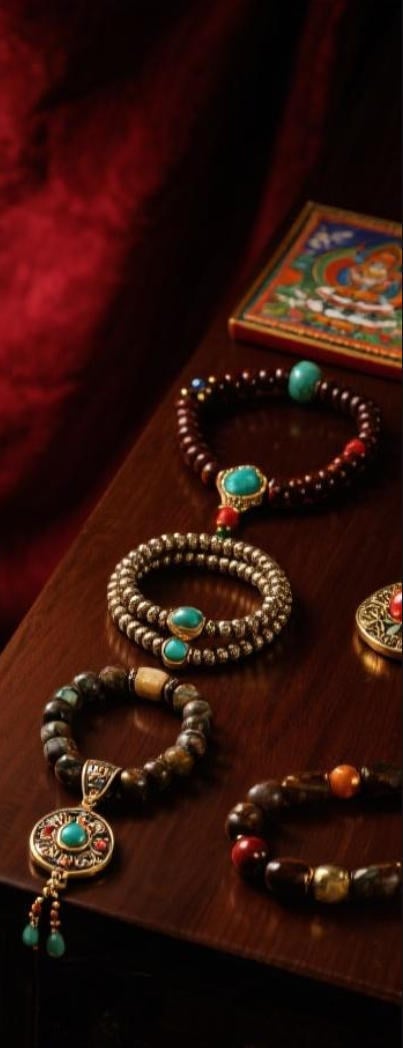
Within the meticulous design of Tibetan Buddhism lie two compelling artifacts: the traditional thangka and bodhi prayer bead. Every single one, in individualized approach, enables transcendental awakening. The thangka, a hand-painted tableau, delineates sacred characters, spiritual mandalas, or traditional chronicles, assisting meditative practice.
Meanwhile, the bodhi bead, often crafted from valuable jewels, planks, fruit stones, or bone, is a tangible reminder of Buddha's realization under the bodhi tree. Employing the beads assists in mental stillness.
- In unison, the thangka and the bodhi bead manifest the marriage of image and mindfulness. They offer a tangible link to the ancient wisdom of Tibetan Buddhism.
Secrets Held in Camel Bones
Over ancient epochs, ancient treasures whisper tales involving a world long departed. These are not precious objects in forgotten empires, but unpretentious camel bones inscribed with glyphs that retain the hidden truths of a bygone age. Each bone holds the echo emanating from a life lived, a journey experienced, and a connection to the primeval wisdom containing which encloses us all.
- They
- Tokens
- Offer
Exploring the Mystical World of Thangka Art
Tangkas are luminous paintings on canvas, meticulously crafted by Tibetan artists to depict divine figures and scenes from Buddhist scriptures. Each detail within a thangka is laden with depth, forming a complex tapestry of visual narratives that guide the viewer on a introspective journey. The pigments used in thangkas are not merely aesthetic choices but carry deeper connotations, denoting different aspects of the Buddhist practice. From the majestic figures to the intricate ornamentation, thangkas offer a outlook into the rich world of Tibetan Buddhism, inviting us to study upon its teachings.
- Historical thangka art often depicts key Buddhist figures such as Buddha Shakyamuni, Bodhisattvas like Avalokiteshvara and Manjushri, and enlightened beings from various orders of Tibetan Buddhism.
- Inside these representations lies a wealth of learnedness that can be unlocked by those who study the symbolic language of thangkas.
Enlightened One's Path to Enlightenment: Embodied in Beads and Bone
Upon the winding course to awakening, the Buddha used insignia imbued with profound value. Separate bead and material held within them the quintessence of his teachings, revealing glimpses into the unfolding of reality. Using their appearance, the Buddha conveyed profound verities that exceed the realm of commonplace perception.
From these meditation beads, crafted from sacred materials, arose vibrations that resonated with the nuanced flows within. The material of a organism, meticulously transformed into emblems, served as tangible signals of the impermanence native to all manifestations.
Thangkas: Windows into Himalayan Spirituality
Thangkas vibrant paintings on cloth serve as influential representations of Himalayan spirituality. These intricate works of art, meticulously created with careful brushstrokes, depict a vast array consisting of Buddhist deities, mandalas, and scenes from ancient scriptures. Each thangka is a visual guide for meditation and contemplation, offering discernment into the multifaceted teachings of Buddhism.
- They are often used in ritual ceremonies during
- manifesting states of spiritual transcendence.
- Thangkas act as not merely decorative works but rather windows into the rich and captivating world of Himalayan spiritual traditions.
The Spiritual Significance of Bodhi Beads in Mindfulness and Compassion
Each bead on a bodhi bead mala whispers tales of ancient wisdom, guiding us on a pilgrimage through the tranquil waters of mindfulness. As we touch these intricately fashioned beads, our fingers trace the contours of individual one, anchoring our alertness in the present moment. The gentle weight of the beads against our palms serves as a tangible reminder to exhale, fostering a sense of stillness.
- At every bead that passes between our fingers, we nurture compassion, extending it first to ourselves and then outward to the world.
- Spiritual doctrines teaches us that mindfulness is a method that requires patience and steadfastness.
By means of the rhythmic repetition of mantra or simply the mindful observation of the beads, we liberate from the relentless chatter of the mind.
The practice incorporating bodhi beads is a delicate invitation to rekindle our connection with ourselves and the world around us.
Spiritual Artistry: Designing Camel Bone Bracelets for Growth
Intention is a powerful force in our lives, shaping our experiences and guiding us towards our ultimate purpose. When we combine this intention with the traditional practices of crafting a camel bone bracelet, we create a potent synergy that can accelerate our spiritual growth.Camel bone remains deeply resonant, representing strength. Its natural beauty and perennial fascination serve as a constant reminder of the core vitality within each of us.As we carefully select each bone, infuse our intentions into the bracelet. With every knot or fastening, we entwine our hopes, dreams, and aspirations for spiritual evolution. This act of creation becomes a sacred ritual, blending us with our inner wisdom and guiding us on a voyage of awakening.- Allow the bone’s pigments to mirror your sacred objectives.
- Channel your willpower throughout the weaving process.
- Wear it as a constant reminder of your commitment to growth and transformation.
The Enduring Impact of Camel Bone in Buddhism
In the rich tapestry embedded in Buddhist tradition, artifacts often hold profound symbolic meaning. Within these varied objects, camel bone stands out as a exceptional and absorbing element. Across history, this material has been incorporated in the crafting of various Buddhist artifacts, each imbued with specific significances.
- Seen as a symbol of resilience and strength due to the camel's ability to withstand in harsh environments, camel bone often signifies spiritual fortitude.
- Complementarily, the color and texture relative to camel bone are believed with some to hold auspicious connotations, manifesting purity and serenity.
Wherefore, camel bone has become a meaningful part of Buddhist folklore, serving as a tangible relation to the profound teachings transmitted through this ancient faith.
Thangka Art: Weaving Tales of Divinity
Within the ethereal realm of Tibetan Buddhism, Thangka paintings emerge as sacred portals to enlightenment. These exquisite works, meticulously crafted by skilled artists known as thangkapa, depict a myriad in an array of vibrant deities, celestial beings, and mythical creatures. Each brushstroke infuses profound spiritual significance, narrating ancient tales and philosophical theories.
- Offering a vast anthology of Buddhist iconography, Thangkas serve as both devotional objects and instructional tools. Faithful practitioners gaze upon these paintings during rituals and meditations, seeking to cultivate spiritual wisdom.
- Beautifully adorned with intricate details embellished by diverse vibrant hues, Thangkas are considered windows into the divine. All painting acts as a symbolic representation of the Bodhisattva's teachings and the path to liberation.
With the aid of their intense imagery and symbolism, Thangka paintings offer a glimpse into the rich religious traditions of Tibet. They are a testament to the enduring artistry of Tibetan art and its profound ability to enlighten.
Embracing the Duality: Thangkas and the Cycle of Life and Death
Thangkas, these colorful embroidered scrolls native to Tibet, provide an insightful exploration into the fleeting nature of life. Each intricate rendering depicts deities and beings engaged in the developing path of life and death, a concert of birth, growth, impermanence, and renewal. The artists skillfully integrate these concepts within the thangka's territory, yoga life highlighting the interconnectedness of all things. Through vivid icons, they invite us to deliberate on our own continuity. The cycle persists, a pattern of coming and going, reinforcing the preciousness of each moment. By embracing this duality, thangkas teach us to value the beauty in both life's joys and sorrows.String of Mindfulness: The Significance of Bracelets in Buddhist Practice
In the intricate tapestry of Buddhist practice, seemingly humble objects often hold profound meaning. Among these are bracelets, which serve as tangible emblems of devotion and commitment to the doctrine of Buddha. Worn on the wrist, a bracelet behaves as a constant reminder of one's aspirations and objectives. It can mirror the impermanence of life, fostering practitioners to remain grounded in the present moment. Some bracelets may incorporate sacred symbols, such as mantras or the names of Buddhas, which are thought to invoke positive energy and protection. Others may be made from materials with spiritual significance, like sandalwood or lotus seeds, adding the bracelet's potency. Ultimately, the significance of a Buddhist bracelet originates far beyond its physical form. It becomes a powerful tool for mindfulness, a motivation to live in harmony with the teachings of Buddha, and a origin of one's unwavering trust.